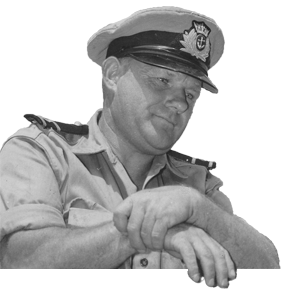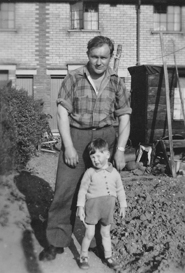Alex Grimes
Makes first ever voyage
from England to New Zealand
in 30ft trimaran yacht in 1962/63

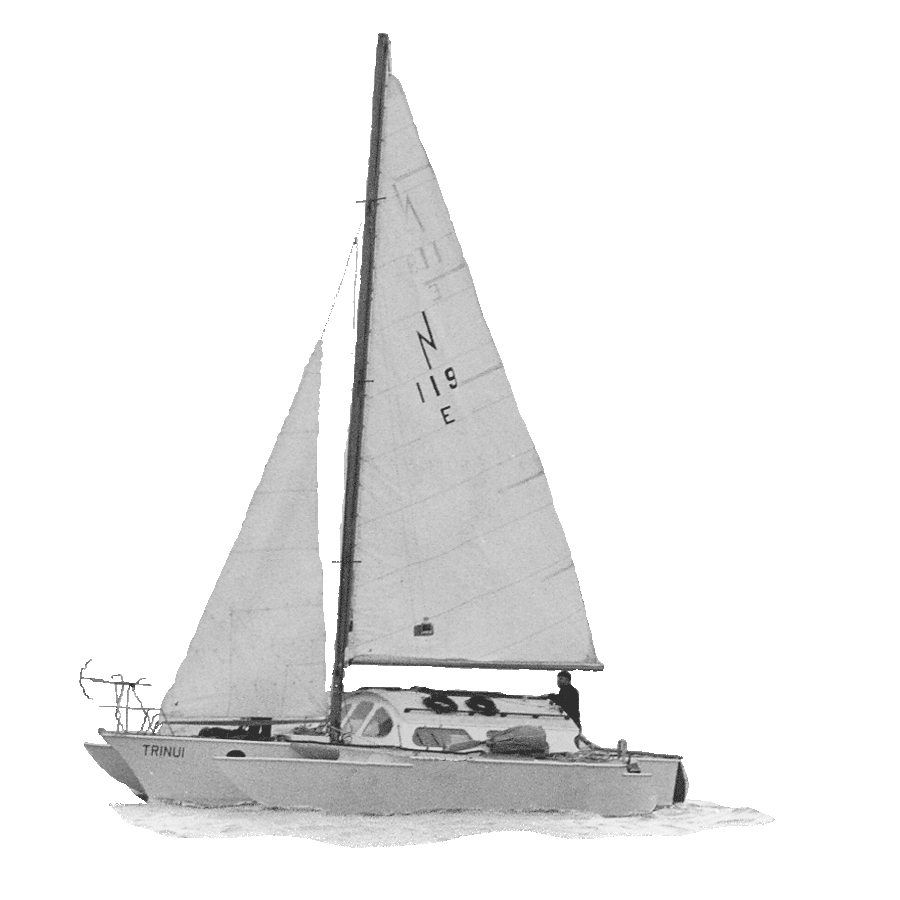
Alex Grimes made the 14 month voyage from his home town of Wells Next the Sea, Norfolk sailing in a 30 foot trimaran named 'Trinui'.
This record voyage for a craft of this kind was documented by D.H. Clarke in his book 'Trimaran Development' as the first trimaran across two oceans, and the first multihull across the Pacific after early Maori migrations.
He set sail 21st September 1962 and arrived in Auckland, New Zealand on 14th December 1963, as quoted in the press at the time,
"... a splendid feat to sail a 30-foot trimaran 11,000 miles across the Atlantic, through Panama, across the Pacific, at one stage several weeks out of touch with the rest of the world, to Auckland in New Zealand ..."
The yacht was built in Norfolk by Contour Craft of Gorleston (subsequently Cox Marine, Ipswich) following Arthur Piver's Pi-Craft plans for the Nimble trimaran. Essentially the craft was built of plywood with an external fibreglass coating to hulls and wings.
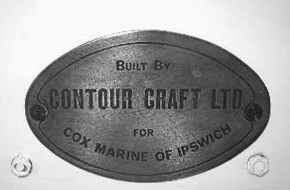
Below is a copy of the Editorial Comment from Norfolk Eastern Daily Press 15th December 1963 announcing the arrival in New Zealand.
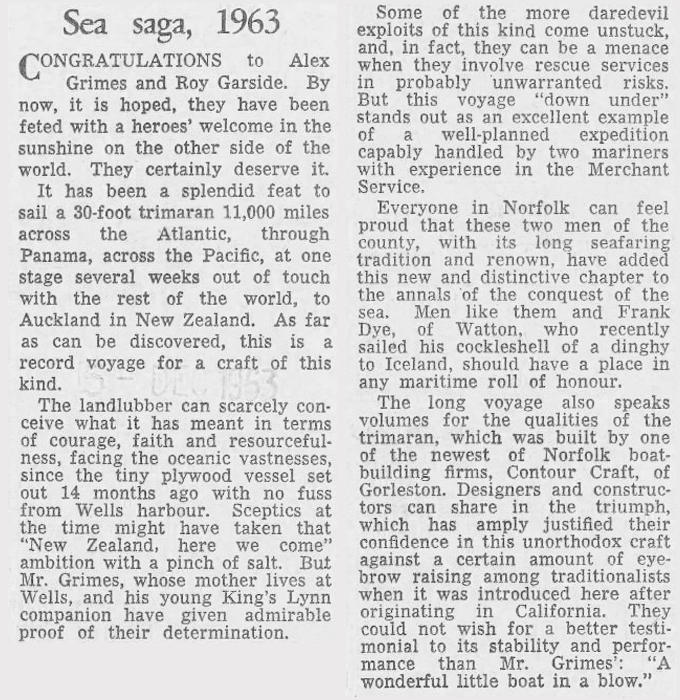
Copyright Eastern Daily Press (note: print layout modified for web page)
There appears to be one particular inaccuracy though: it is more like a total sailing distance of 15,000 miles (13,000 nautical miles), not 11,000 (9,500 nautical miles), which is probably the 'Great Circle' distance as measured on the globe.
To follow up the reference to Frank Dye of Watton and sailing his cockleshell of a dinghy to Iceland, click here.

Press photos
These are the press photos taken by the EDP newspaper at the time of departure from Wells
All press photos copyright Eastern Daily Press
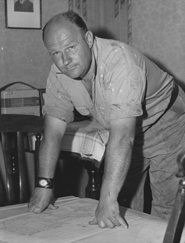 Alex at the home of his mother (21 Northfield Crescent, Wells) plotting courses to NZ. The chart is for the Canary Islands, to pick up the north east trade winds.
Alex at the home of his mother (21 Northfield Crescent, Wells) plotting courses to NZ. The chart is for the Canary Islands, to pick up the north east trade winds.
I think the radio in the background was a Grundig Yacht Boy shortwave set. It was the sole communication equipment taken on board, capable only of receiving transmissions.
Partly visible on the wall is a photo of his elder brother, Leslie, my father, who also became a Master Mariner in the Merchant Navy.
 Trinui at anchor in the harbour at Wells.
Trinui at anchor in the harbour at Wells.
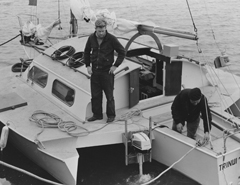 Shipmate Roy Garside and Alex checking out the outboard motor.
Shipmate Roy Garside and Alex checking out the outboard motor.
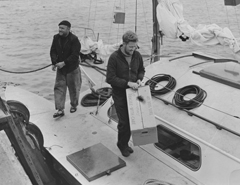 Alex and Roy loading stores prior to departure.
Alex and Roy loading stores prior to departure.
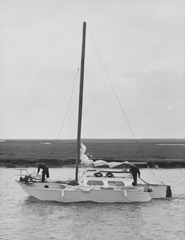 Trinui in 'The Run' out of Wells bound for New Zealand.
Trinui in 'The Run' out of Wells bound for New Zealand.
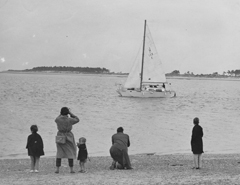 Trinui finally off under sail!
Trinui finally off under sail!

Some of our own family photos
We took these when I went with some of my family to Wells from Yorkshire in September 1962 to wish my uncle Alex a safe voyage.
The quality is not so good as they were taken with a miniature 35mm film camera.
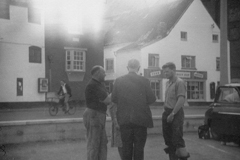 Alex and Roy on Wells quayside discussing voyage and possible press coverage with my great uncle Frank Barrett and his wife Jean. Both Alex and Roy were against any publicity for the voyage, other than coverage in the local newspaper.
Alex and Roy on Wells quayside discussing voyage and possible press coverage with my great uncle Frank Barrett and his wife Jean. Both Alex and Roy were against any publicity for the voyage, other than coverage in the local newspaper.
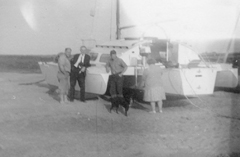 Trinui at low tide moorings at Wells harbour. Here are Alex, my great uncle Frank, Roy, Frank's wife Jean, and their dog making an inspection.
Trinui at low tide moorings at Wells harbour. Here are Alex, my great uncle Frank, Roy, Frank's wife Jean, and their dog making an inspection.
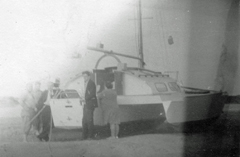 This shot has Alex, Roy, great uncle Frank, EDP's photographer and Jean. Dog's gone swimming!
This shot has Alex, Roy, great uncle Frank, EDP's photographer and Jean. Dog's gone swimming!
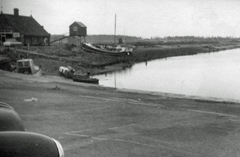 Alex and Roy launching jolly boat in Wells Harbour to take someone across to the Trinui. It wasn't me, although I did get across eventually and slept overnight on board; quite an adventure for a sixteen year old.
Alex and Roy launching jolly boat in Wells Harbour to take someone across to the Trinui. It wasn't me, although I did get across eventually and slept overnight on board; quite an adventure for a sixteen year old.
 Alex rowing someone out to the Trinui. Roy is in the bow.
Alex rowing someone out to the Trinui. Roy is in the bow.
 Nearly there, with the tide on it's way in.
Nearly there, with the tide on it's way in.
 Safely ashore but with wet feet.
Safely ashore but with wet feet.
 High tide; time to come back to quayside.
High tide; time to come back to quayside.

Building of the 'Trinui'
Eastern Daily Press article dated around end of July 1962
"He intends to sail across the Atlantic and through the Panama Canal and to call at Tahiti and the Cook Islands on his way ... Mr Grimes is the second son of Mrs and the late Mr [William] Grimes. His father was in the navy in the first world war and at one time was a member of Wells lifeboat crew. His elder brother Leslie is the master of a coastal vessel (Ashleigh ex Magrix)."
"He has no previous experience of sailing but he hopes to get used to it on board the new trimaran."
"While in New Zealand he has been chief officer on a coastal ship (Maranui) and he intends to take up a similar job when he gets back there."
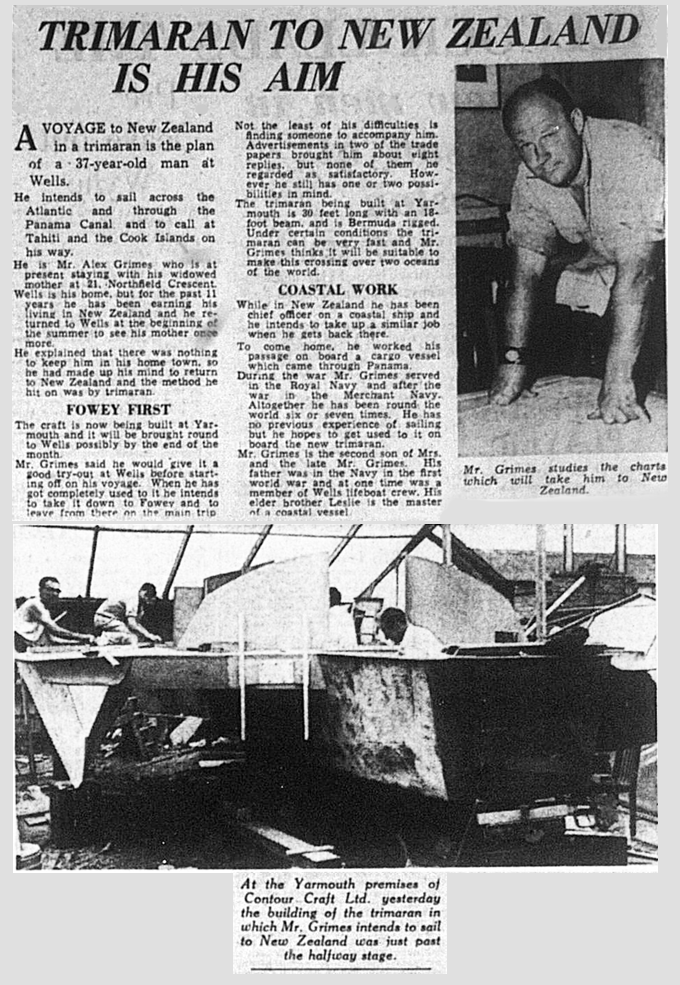
Copyright Eastern Daily Press (note: print layout modified for web page)

Crewmate recruited
Eastern Daily Press article dated 11th September 1962
"After searching for a crew and companion for a voyage to New Zealand in a trimaran, Mr Alex Grimes a 37-year-old merchant navy officer from Wells has chosen a King's Lynn seaman ... Mr Roy Garside, aged 21."
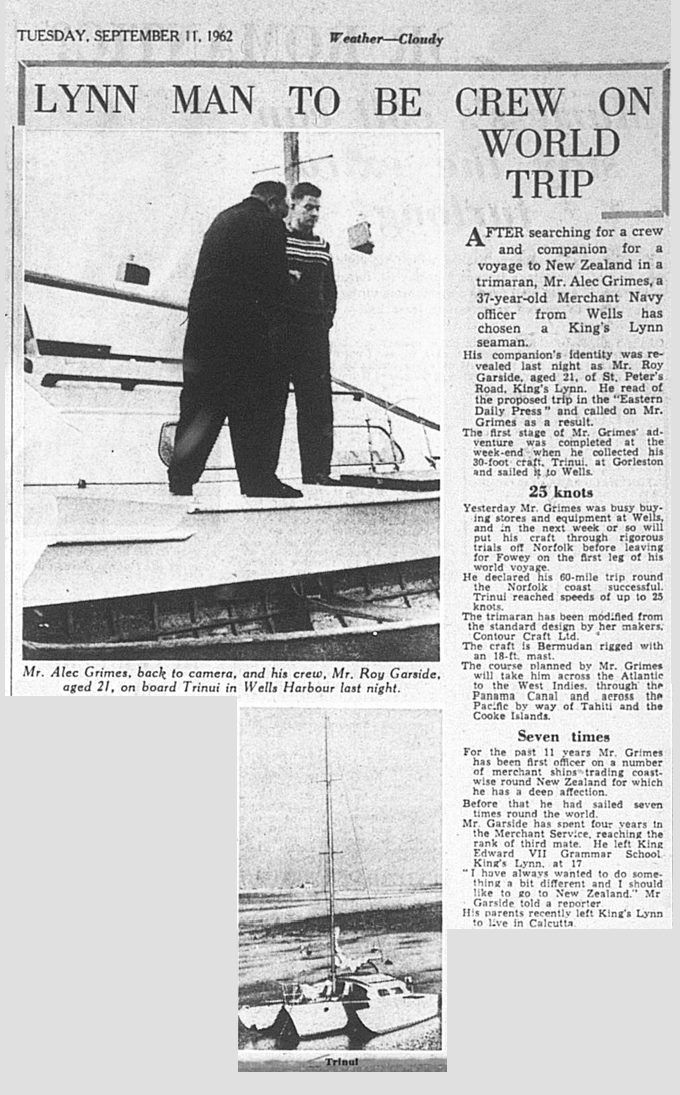
Copyright Eastern Daily Press (note: print layout modified for web page)

Damage to 'Trinui'
Eastern Daily Press article dated 27th May 1963
"A freak sea at the beginning of the month just off Rarotonga in the Cook Islands damaged the port float ... he [Alex] says he expects to be in the Cook Islands for two or three weeks ..."
"Pulling into Pape'ete, he was most impressed by the powered bicycles that went streaming by, ridden by Tahitian girls with long hair way down past their waists and all with flowers in their hair and wearing brightly coloured sarongs."
"He described the meals on board ... I cooked rice with dehydrated peas while Roy cooked dehydrated spuds and beans called caraotas [black beans] and garbanzo [chickpeas] beans. One tastes like butter beans, the other like hazel nuts."

Copyright Eastern Daily Press (note: print layout modified for web page)

Arrival in New Zealand
Eastern Daily Press article dated 15th December 1963
"Mr Grimes' mother yesterday received a cable which told her of his [Alex] safe arrival in New Zealand ... When I opened the cable and read what was on it I felt immensely relieved."
"Although I always knew he would get there I was a little worried at times as every mother would be. My only wish is that I could have been there to greet him as he came ashore."
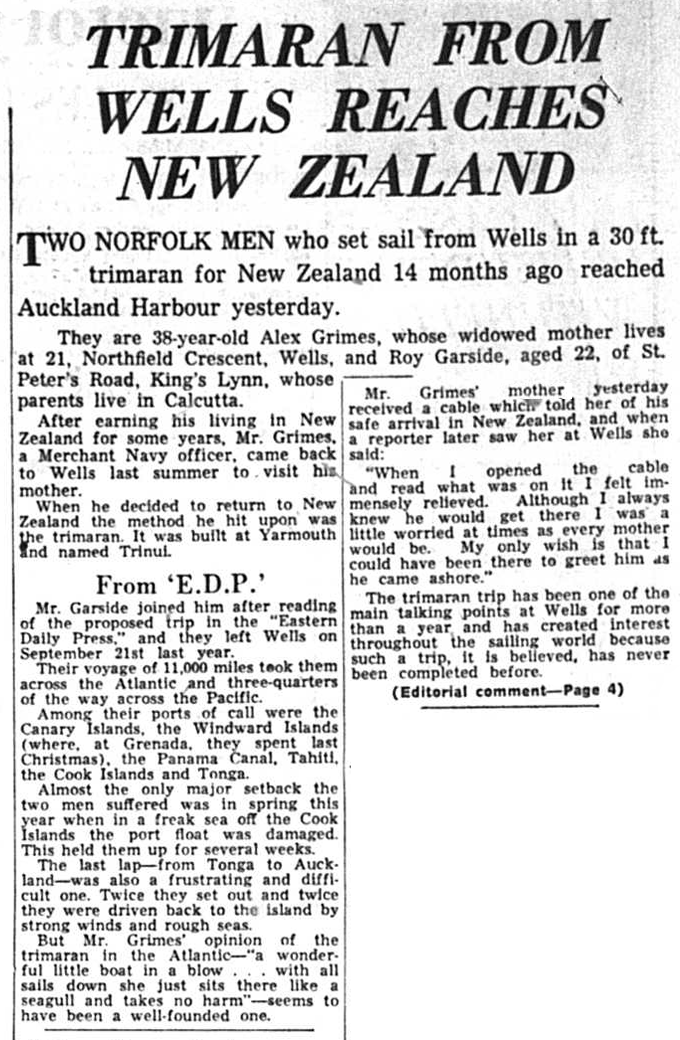
Copyright Eastern Daily Press (note: print layout modified for web page)

Visit of Queen Elizabeth II and Duke of Edinburgh 1963
Alex arrived in Auckland the same year that Queen Elizabeth and the Duke of Edinburgh made their second visit to New Zealand and this video perhaps gives a flavour of the country at that time.

Extract from 'boatdesign.net' blog
First trimaran voyage from England to New Zealand
"... after the first Piver Nimble voyage from England to New Zealand made by sailor Alex Grimes ..."

Copyright Boat Design Net

Rough chronology of the voyage
(some dates estimated by landlubber author)
| 8th September 1962 | Trinui launched Yarmouth |
| 21st September 1962 | Left Wells for Fowey |
| November 1962 | Canary Islands |
| Christmas 1962 | Grenada, Windward Islands |
| February 1963 | Left Panama Canal for Tahiti |
| February 1963 | Becalmed off Galapagos Islands |
| April 1963 | Pape'ete, Tahiti |
| 1st May 1963 | Sighted Rarotonga, Cook Islands |
| 9th May 1963 | Avatiu harbour, Cook Islands |
| June to October 1963 | Two unsuccessful attempts for NZ |
| October/November 1963 | Third attempt for NZ |
| 14th December 1963 | Arrived Auckland, NZ |
Plot of course taken for voyage
(again, course estimated by landlubber author)
Google Map of the approximate course of the voyage:
and you can also click here to view in Google Maps in a new window.

Epilogue
And after completing the voyage ...
Trinui was sold soon after arriving in Auckland and Alex worked for several years in the New Zealand merchant navy, including being master on the ferry between North and South Islands.
Alex's eventual home in New Zealand was near Kohukohu, Hokianga Harbour.
Quoting from a letter received from a close friend after his death in 1998:
"Alex acquired a small house and a couple of acres in the far north of NZ, at Kohukohu, on the Hokianga Harbour. Although a somewhat isolated spot, he walked for hours with one or other of his two dogs, over the local hills."
His crewmate Roy Garside settled in New Zealand, joining the Union Steam Ship Company and sailing for about a year as Second and Third Officer. He then changed career direction and studied surveying at Otago University, graduating as a land surveyor in 1968.
He returned to Britain and married his childhood sweetheart, Ruth, and eventually went back to New Zealand where he worked as a land surveyor firstly in Dunedin and then Christchurch. He died in 2003, aged 63, of an inoperable brain tumour.
In his obituary in the New Zealand Pess, it was noted that he navigated on the voyage with just a 1924 sextant (no modern technology, such as GPS or two-way radio). He is quoted as saying about the voyage:
"At worst, it was standing waist-high in water at the helm, battling a gale and surviving on onions and custard powder. At best, it was being greeted in tropical ports by friendly people."

Notes on Piver 'Nimble' trimarans
(copyright Pi-Craft designs)

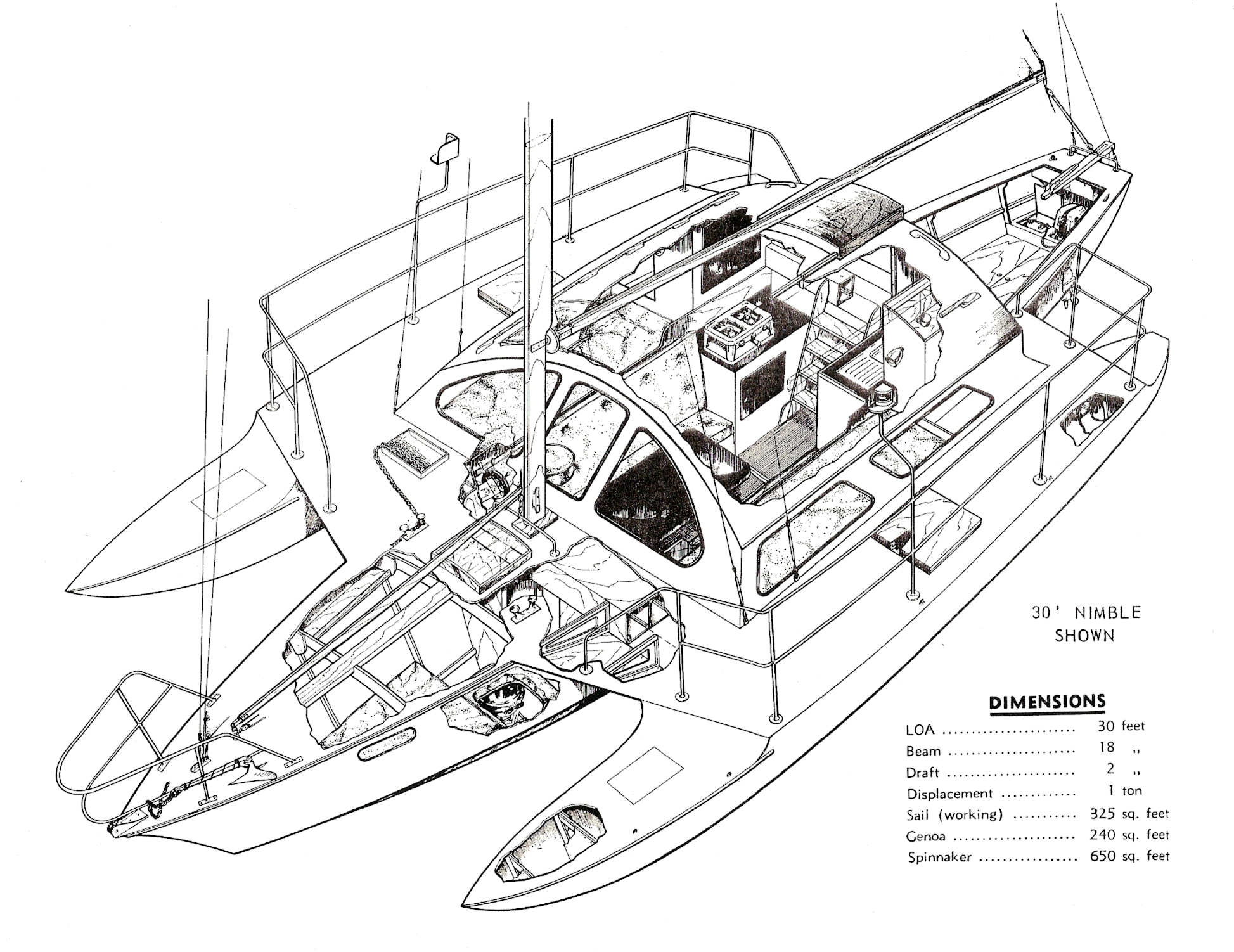
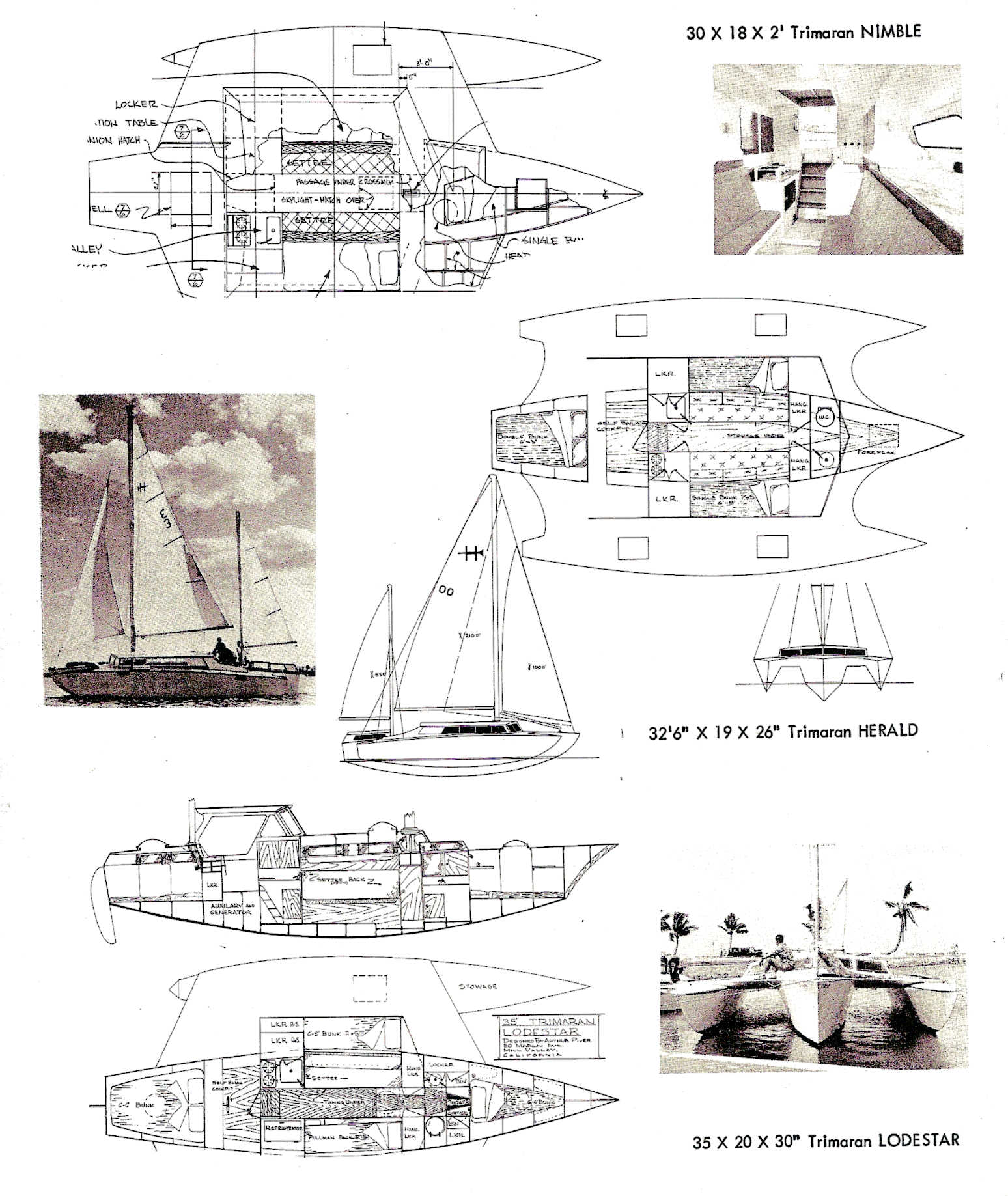
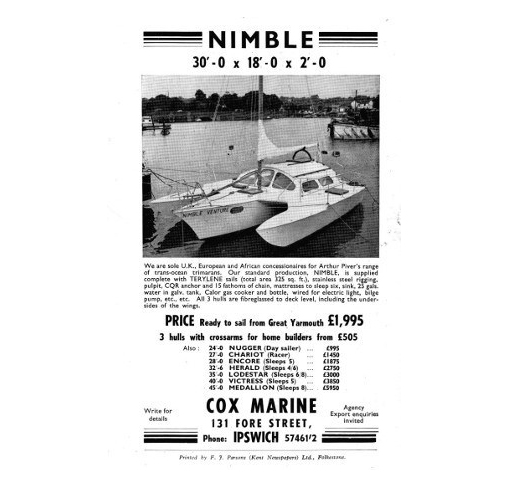
Extract from 'boatdesign.net' blog
Description of Piver Nimble construction
"The Nimble was 30 x 18 foot with a weight of 2240 lbs (optimistic), some claim 3800 lbs, and 325 square foot of working sail area. An optional 240 square foot genoa and a 650 square foot spinnaker were available. The floats had mini fins on them for lateral resistance. The draft was 2 foot with a hard chine main hull and deep V floats.
It was a plywood timber build with 9 mm plywood on the hulls, decks and bulkheads with 18 x 25 mm stringers and 19 x 65 mm chines. The forward box plywood cross beam was 450 x 225 mm. The box beam was of 9 mm plywood with 2 layers of 9mm the closer to the centre line. The aft beam was 250 x 225 mm of the same construction. Additional timber strips were added to the box beams for strength."

Copyright Boat Design Net

Extracts from Pi-Craft Trimaran catalogue 1970
Trimaran strength
Arthur Piver owner of Pi-Craft wrote in testament of his trimaran's design,
"The supreme test occurred [in 1960], which was the crossing of the Atlantic by NIMBLE. You can sail around the harbor and along the coast for a hundred years and still not know how your boat would act in a storm far at sea.
The voyage began inauspiciously, consisting of drifting around the Nantucket Lightship for several days in dead calm and pea-soup fog. Then things began to really happen. A storm arose at night - developing into ten days of continual NW gales which thoroughly tested the trimaran and its crew.
The boat was at first run off before the tempest, with a warp dragging astern according to custom, for what had been acknowledged the most dangerous situation was to go too fast down-wind for fear of broaching (an uncontrollable turn into the wind) or running clear underwater at the bottom of a wave.
Once the trailing warp twisted upon itself, apparently reducing its drag, and as the wave steepened prior to breaking, the trimaran simply surfed ahead of it, and the wave broke well astern! This was all that was needed to know, and the warp was henceforth pulled in, and the boat surfed for hour after hour, with no water on deck except for wind-driven spray from adjacent breaking waves. Then an even more exciting discovery was made - if the waves were sufficiently large NIMBLE could surf across them like a surfboard, giving even greater speed and more choice of direction."
and of its strength,
"Despite simple, unballasted construction our trimarans are proportionately stronger than any other type. Consider the case of the one which landed on a Hawaiian reef in the late Fall of 1963. For over 20 hours it was smashed against jagged coral by large seas and received only MINOR damage. No other boat - regardless of type of construction - could have withstood such a merciless beating. Again this was a display of the reduction of impulse forces by light weight."

